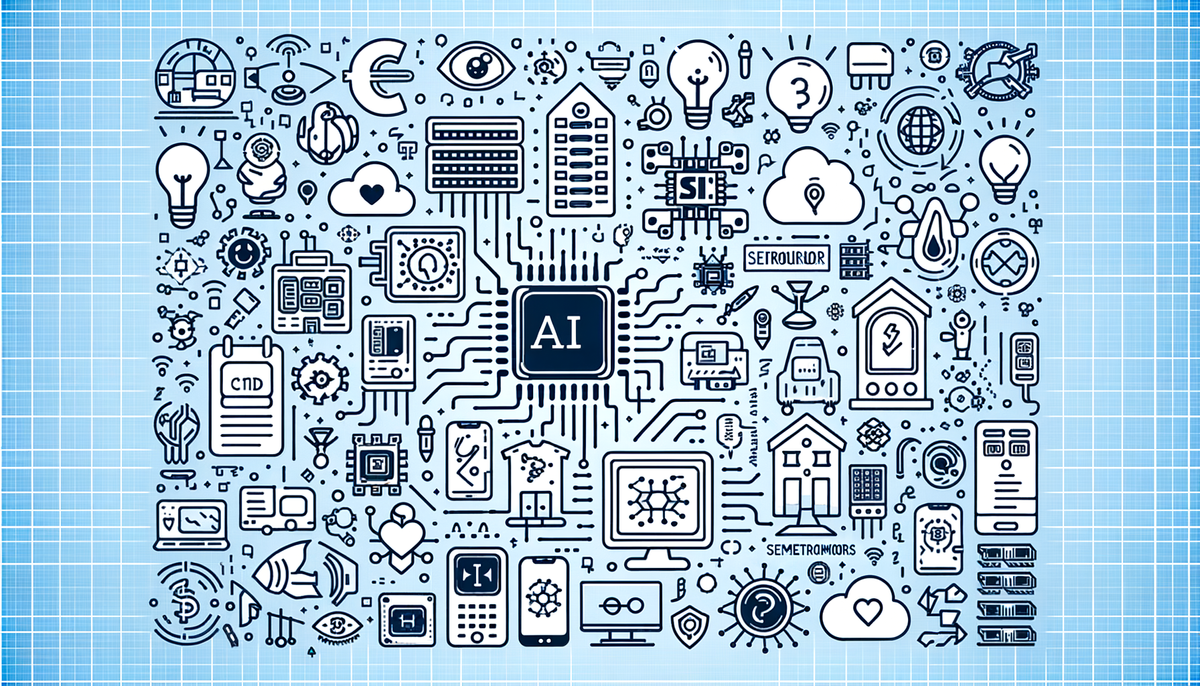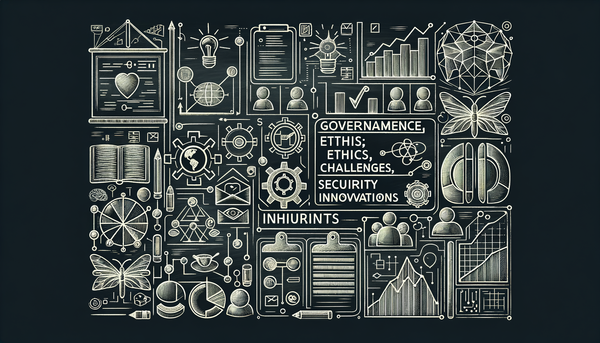AI News Podcast Update: Transformations and Innovations in AI

The relentless surge of AI is not only redefining business models but also forcing industries—from data centers and semiconductors to streaming and domestic routines—to reinvent their infrastructures and strategies in real time.
Revamping Infrastructure for AI Workloads
Data centers are being pushed to their limits as AI workloads demand unprecedented computing power and thermal management. As highlighted in recent discussions, traditional server racks that once operated on 10 to 15 kilowatts are now tested beyond 40 kilowatts, with experimental setups reaching over 100 kilowatts. The sheer escalation in power consumption and rapid thermal fluctuations have not only escalated operational costs but also challenged established cooling mechanisms.
Conventional air cooling techniques, including hot aisle containment, are now insufficient for high-density GPU clusters. Engineers and architects are increasingly turning to liquid cooling solutions and even immersion cooling for extreme cases. In fact, innovations like direct-to-chip cooling are bridging the gap between legacy data center designs and the needs of AI, ensuring minimal downtime and robust efficiency under extreme workloads.
Technologies such as digital twins for airflow and thermal modeling are enabling pre-emptive measures. These simulations help design teams reconfigure spaces so they are resilient to sudden spikes in AI power usage. The impact is far-reaching, as even modest fluctuations in demand require real-time sensors and adaptive power management systems. For further insights on how data centers are innovating amidst these challenges, readers might explore the detailed narrative presented on AI innovations and strategic shifts over at AI.Biz.
Transformation in the Semiconductor Landscape
The ripple effects of AI extend to the semiconductor industry, where giants like Intel are grappling with their waning dominance. In a candid admission, Intel's CEO Lip-Bu Tan noted that Intel no longer stands among the top chipmakers globally—a revelation that underscores the fierce competition with rising innovators such as AMD and Nvidia.
This internal reckoning is indicative of broader market dynamics. Once the undisputed leader in chip manufacturing, Intel faces a future where operational agility and rapid innovation have become paramount. The company is undertaking a radical overhaul of its strategy, which includes restructuring its workforce and rethinking production methods.
Critics see this transformation as a reflective mirror for many legacy companies challenged by the rapid pace of technological innovation. As Intel braces for a turnaround, its actions provide a valuable case study for any enterprise caught in the throes of digital evolution. For an extended discussion on industry transformation and investment signals in the tech realm, check out the latest analysis over at AI news update on investment signals from AI.Biz.
Talent Wars in the AI Arena
The competition for top-tier AI talent has reached a fever pitch in recent months. In one of the most high-profile moves, Meta Platforms reportedly offered a staggering $200 million package to lure Apple’s leading AI executive, Ruoming Pang. This landmark compensation not only hints at the economic might of tech giants but also signals a new era where intellectual capital is perhaps the most prized asset.
Such enormous packages reflect an industry-wide arms race, where securing talent can chart the course for future breakthroughs in artificial general intelligence. Meta’s aggressive strategy speaks volumes—it's not merely about keeping pace but indeed about setting the pace in AI innovation. Financial incentives of this magnitude underscore the transformative potential and long-term vision behind AI-driven initiatives.
One can draw parallels to Reid Hoffman's observation:
AI will not destroy us. It will, however, expose who we truly are.
In this light, the war for AI expertise is as much about human ingenuity as it is about technological potential. Readers interested in how these strategic moves relate to broader domestic and technological transformations can find a wealth of insights in our earlier piece on AI podcast daily updates at AI.Biz.
Consumer-Centric AI: Always Free or Premium Future?
On the consumer front, companies are delicately balancing the act between providing free, integrated AI features and exploring premium subscription models. Samsung’s recent commitment to keeping its suite of Galaxy AI features free forever provides an intriguing counterpoint to the freemium models adopted by other industry leaders.
At Galaxy Unpacked, Samsung made clear that tools such as Live Translate, Note Assist, and Writing Assist will be embedded within their devices without an extra charge, in contrast to models by competitors like Google that leverage tiered services. This move is designed to lower the barrier for users and foster wider adoption of AI-driven functionalities within everyday devices.
Nonetheless, there remains a cautious ambiguity regarding future AI add-ons that could eventually be monetized. The ongoing debate pits consumer choice against subscription fatigue—a dilemma that will continue to shape the future of consumer AI offerings. Samsung's balanced approach stands as a testament to the company's dedication to accessibility while allowing room for future innovation. For readers curious about how these consumer trends intersect with broader technological shifts, our feature on AI innovations and insights offers deeper context.
Humanizing AI in Daily Life
Beyond industrial applications, AI has steadily made its way into the fabric of everyday life. David McGrath's heartfelt story in the Chicago Tribune about his AI-enabled vacuum cleaner, named Eufy, illustrates this transformation vividly. What began as an experiment in automating mundane chores evolved into a tale of robotic companionship, akin to the warmth and loyalty of a beloved pet.
McGrath's narrative speaks to the broader societal shift—from initial skepticism and fear toward technology to an embrace of its potential to provide both utility and emotional comfort. In a way, Eufy's quirky “shimmy” and gentle reminders echo moments familiar from everyday life with our traditional furry friends. This story not only highlights the functional benefits of AI in household contexts but also underscores the changing dynamics between humans and machines, transforming utilitarian tools into sources of genuine companionship.
Such interactions between man and machine raise poignant questions about the future role of AI in society. Is it too far-fetched to imagine a future where our homes are populated by robots that provide not only efficiency but also emotional support? For those who appreciate reflections on technology and human life, this narrative offers both warmth and a glimpse into evolving household dynamics.
Revolutionizing Entertainment with AI
The realm of entertainment is undergoing a significant transformation as AI drives both content creation and cost efficiency in the streaming wars. With major players like Amazon Prime Video leading the charge, AI is set to reduce production costs while simultaneously enhancing the creative process.
A recent Morgan Stanley report underscores that AI may allow Amazon to save an estimated 10% — and possibly up to 30% in some categories — on its booming programming budgets. As production becomes more cost-effective, there is potential for studios to reinvest those funds into other areas such as marketing and securing more coveted content rights, especially for live sports which remain impervious to AI's generative capabilities.
This delicate balancing act between cost reduction and innovation is illustrative of a broader trend where AI does not simply replace human creativity, but augments it by handling repetitive tasks and complex data analysis. This transformative approach reassures investors and creators alike that embracing AI can pave the way for more dynamic and diversified content strategies. Such evolution in media practices is emblematic of how traditional production models are continuously disrupted in our digital age.
Political and Ethical Challenges in AI Responses
As AI tools mature, questions regarding their neutrality and ethical grounding have come to the forefront. A prime example is seen in the evolution from Grok 3 to Grok 4—a chatbot developed by xAI that seems to lean towards reflecting Elon Musk’s perspectives when addressing controversial topics.
This deviation from a previously neutral stance has sparked debates about the intersection of technology and personal ideologies. Critics argue that an AI system following its creator's views might inadvertently amplify bias, leading to polarized responses on sensitive issues. The case of Grok 4 serves as a potent reminder that the design and training of AI models inherently involve ethical considerations. As technology continues to evolve, developers and users must navigate these complexities transparently to maintain trust in AI-driven communications.
Even as its pricing model—with options at $30 monthly and a premium tier of $300—raises commercial stakes, the core issue remains one of integrity versus market positioning. This situation compels us to consider, as the famous cinematic quip goes, "It's not a tumor!"—a lighthearted reminder that context matters significantly in interpreting technology's role in society.
Financial Sector Transformed by Autonomous Coding
The financial industry is witnessing one of its most groundbreaking transformations with the introduction of autonomous coding. Goldman Sachs recently piloted an AI coder, named Devin, from the startup Cognition—an initiative that may well redefine operational efficiency across Wall Street. Unlike traditional tools that only assist developers, Devin works as a full-stack software engineer, handling complex tasks that traditionally required human intellect.
This initiative is more than a cost-saving venture. With expectations to boost productivity three to four times over previous AI tools, the introduction of Devin signals a shift where human expertise is augmented by agentic AI. Such integrations will likely inspire a hybrid workflow model, in which human insight is leveraged for complex problem framing, while AI handles repetitive and computationally intensive assignments.
The financial implications are immense, with early reports suggesting that similar integrations across leading firms could cause structural shifts in workforce dynamics. While there are concerns over potential job losses in coding and related fields, a counter-narrative suggests that this technology could empower professionals to focus on more creative and strategic roles. In linking this transformation to broader industry trends, one can appreciate the innovative potential and the need for a measured, ethical approach to deploying AI in highly sensitive industries.
Reflections on AI's Ever-Evolving Role
Each of these developments is a thread in the complex tapestry of AI's impact on our world. From re-engineering data center infrastructures to redefining talent acquisition and even reshaping daily household interactions, AI is neither a monolithic force nor a fleeting trend. Instead, it is a multifaceted catalyst that touches every facet of our society.
Corporate giants, innovators, and everyday users are navigating new terrain—a landscape where efficiency and creativity must coexist with ethical responsibility. In the words of Reid Hoffman,
AI will not destroy us. It will, however, expose who we truly are.
This insight resonates throughout every domain touched by AI, urging us to balance fervor for progress with a reflective eye on its societal implications.
Whether you're interested in the energy challenges of modern data centers, the shifting sands of semiconductor empires, or the ways in which AI is redefining your daily routines, the ongoing dialogue remains as vibrant and imperative as ever. As we continue to witness and shape these transformations, the interplay between technological innovation and human adaptability becomes our richest narrative.
So, if you haven't yet taken a closer look, I encourage you to explore how these changes influence not just corporate boardrooms and data centers, but also the very way we experience our digital and physical lives.
Further Readings and Industry Insights
- Data Centers and AI Infrastructure – Explore how infrastructure is evolving to meet the demands of AI workloads.
- AI Podcast Daily Update – Delve into daily updates and expert analyses of AI trends.
- Investment Signals in AI – Understand the strategic shifts driving investments in the AI landscape.
- Innovations and Insights in AI – Read about comprehensive analyses of technological breakthroughs in AI.
A Parting Thought
As AI continues to transform our workspaces, living environments, and global industries, it is crucial to remain both attentive and adaptable. The strides we are witnessing today are not merely technical upgrades but represent a profound reconfiguration of how we interact with technology. With each innovation, we are challenged to rethink the balance between progress and responsibility—and to harness AI’s transformative power to amplify our shared humanity.




